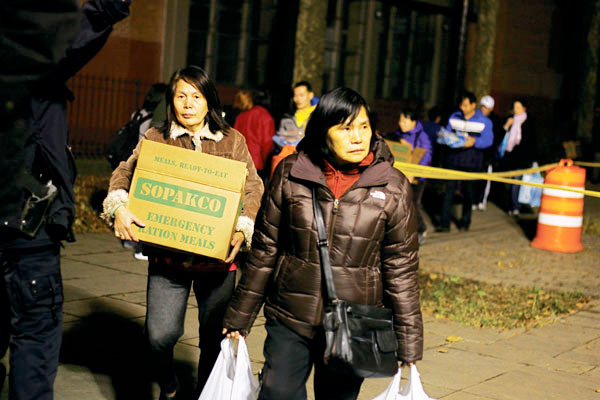
BY JOSH ROGERS | Nine Lower East Side public housing complexes will be able to tap into a $3 billion federal fund to repair damage from Hurricane Sandy, Senator Chuck Schumer and Mayor Bill de Blasio recently announced in Red Hook.
The nine developments are part of 33 NYCHA projects around the city that will receive the Federal Emergency Management Agency money to repair and protect places damaged three years ago.
At the March 31 announcement, the mayor and Schumer said it was the largest single grant FEMA has ever made.
In Downtown Manhattan, the NYCHA complexes that will get this funding include the Smith Houses, LaGuardia Houses, Baruch Houses, Two Bridges, Wald Houses, Riis Houses 1 and 2, and Campos Plaza 1 and 2.
“I know we have to protect our boilers because we had no water during Sandy,” said Aixa Torres, a tenant leader at Smith Houses next to the Brooklyn Bridge.
“I am very happy about the 3 billion,” Torres said last. “I’m sure there’ll be another Sandy with this crazy weather… .
“I think for too long the federal government has ignored public housing in general. We’re taxpayers like everyone else.”
Underscoring that last point, NYCHA estimates that there is an additional $18 billion shortfall citywide on needed repairs at more than 300 developments.
It’s not yet known how much money each housing project will get, but the average is slightly more than $90 million. Torres said all the needed repairs at Smith will cost $623 million, though not all of that is connected to Sandy damage.
Smith needs backup generators and protection for its boilers, two projects eligible for the FEMA funds.
Torres said the complex’s water tank was first damaged in 2011, first by an earthquake and then by Hurricane Irene, which did not hit New York City particularly hard, and then, a year later, by Sandy. After the superstorm, most Smith residents lacked power or water for a week.
She said only half of Smith’s leaky roofs have been repaired and the elevators also need replacing.
About half of the FEMA money will go toward repairs, and the rest will be for flood-protection measures, which is especially important for Smith, LaGuardia and Two Bridges.
All three developments have been cut out of the first phase of the “Big U,” another federally funded project that aims to build a “U”-shaped barrier of protective berms and deployable walls around the southern half of Manhattan.
The U.S. Department of Housing and Urban Development has earmarked $335 million to build at least part of the first section — along the East Side from Montgomery St. up to E. 23rd St.
In a press release, Schumer said, “For thousands of hard-working New York families and seniors in some 200 NYCHA buildings from Red Hook to Coney Island to the Lower East to the Rockaways who were displaced and devastated by Superstorm Sandy, this massive and historic federal investment…will both restore decent living conditions to their buildings and fortify them against future storms and disasters.”
Joining the release from the mayor were a long list of politicians, including on the local level, U.S. Representatives Nydia Velázquez and Carolyn Maloney, Borough President Gale Brewer and Councilmember Margaret Chin.
Chin said the money “represents a huge step toward improving the lives of thousands of Lower East Side NYCHA residents who are still struggling with post-Sandy damage and the fear of being left unprotected.” With the funding, she said, “We can get much closer to truly protecting those public housing residents for generations to come.”
































